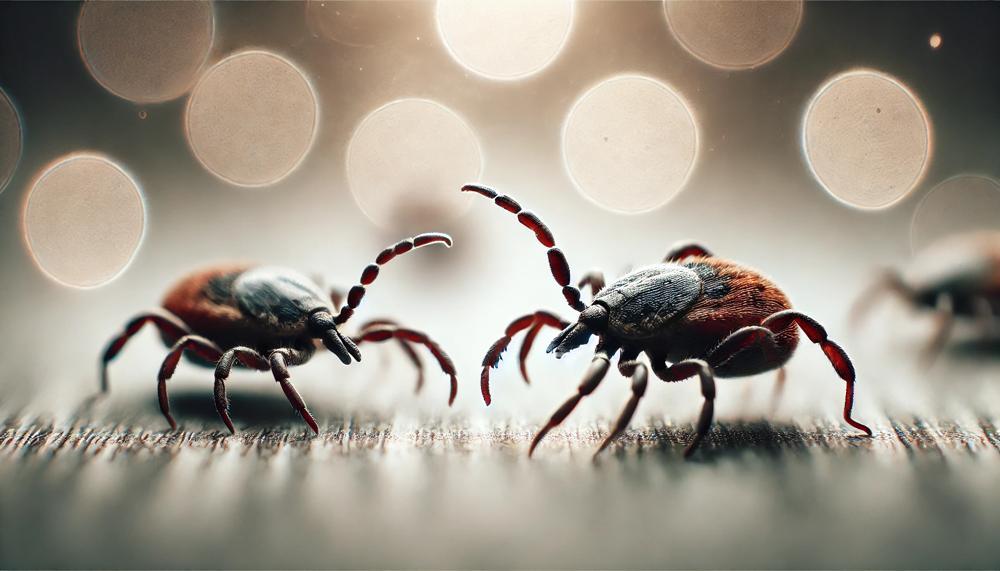Ticks are top on the list of little critters that may make you tremble. But have you ever wondered whether these parasites that feed on human blood can fly? Prepare to explore the intriguing realm of ticks as we solve the enigma surrounding their potential for flight. Come along on this exploratory voyage with us as we investigate:
- The anatomy of a tick: Delving into the intricate structure of these tiny creatures, we’ll uncover the secrets behind their unique physical characteristics.
- A closer look at tick locomotion: Witness the remarkable ways in which ticks navigate their surroundings, revealing the strategies they employ to find their next blood meal.
- Debunking common myths: We’ll shatter long-held misconceptions about ticks, separating fact from fiction and providing a clearer understanding of their behavior.
- The significance of tick-borne diseases: Uncover the potential health risks associated with tick bites, emphasizing the importance of prevention and awareness.
- Protective measures against ticks: Discover practical tips and strategies to safeguard yourself from tick encounters, ensuring your outdoor adventures remain enjoyable and safe.
Prepare to be amazed as we embark on this exploration of ticks and their intriguing characteristics. Get ready to have your curiosity ignited and your knowledge expanded as we delve into the fascinating world of these tiny creatures.
Table of Contents
- 1 The Unique Anatomy of Ticks: Exploring Their Wingless Bodies
- 2 Understanding the Life Cycle of Ticks: From Larvae to Adult
- 3 The Role of Ticks in the Ecosystem: Why They Don’t Need Wings
- 4 Common Misconceptions about Ticks: Debunking the Myth of Wings
- 5 The Dangers of Ticks: Recognizing the Risks of Tick-Borne Diseases
- 6 Preventive Measures for Tick Control Around Your Home and Property
- 7 Conclusion
The Unique Anatomy of Ticks: Exploring Their Wingless Bodies
| Reason | Explanation |
|---|---|
| Parasitic Lifestyle | Unlike insects that rely on flight for food and survival, ticks have adapted to a parasitic lifestyle. They attach themselves to hosts and feed on their blood, eliminating the need for wings. |
| Body Structure | Ticks possess a unique body structure that is not conducive to flight. Their flattened bodies and lack of wing muscles make it impractical for them to generate the necessary lift and maneuverability required for flying. |
| Evolutionary Adaptation | Through evolutionary adaptation, ticks have specialized in exploiting their hosts for nourishment and protection. Their wingless bodies have allowed them to become highly efficient parasites, capable of attaching to and feeding on a wide range of hosts. |
Understanding the Life Cycle of Ticks: From Larvae to Adult
| Stage | Wings |
|---|---|
| Egg | No |
| Larva | No |
| Nymph | No |
| Adult | No |
Throughout their life cycle, ticks do not develop wings at any stage. They belong to the arachnid class, which includes spiders, mites, and scorpions, and none of these creatures possess wings.
Ticks have a distinct body structure consisting of four pairs of legs and a segmented body that undergoes several developmental stages without ever growing wings.
The Role of Ticks in the Ecosystem: Why They Don’t Need Wings
| Tick Traits | Implications for Wings |
|---|---|
| Stationary Hosts | No need for active pursuit |
| Ambush Predators | Wings would hinder stealth |
| Specialized Adaptations | Legs and mouthparts for attachment |
| Efficient Blood-Feeding | Wings would interfere with feeding |
- Ticks, unlike many other insects, do not possess wings due to their unique feeding strategy and adaptations.
- Their primary hosts, often large and slow-moving animals, remain relatively stationary, eliminating the need for active pursuit.
- As ambush predators, ticks rely on stealth and patience to latch onto their hosts. Wings would hinder their ability to remain concealed and surprise their prey.
- Ticks have evolved specialized adaptations, such as strong legs for clinging and piercing mouthparts, which enable them to attach firmly to their hosts and feed efficiently.
- Wings would not only be unnecessary but also hinder their ability to maintain a stable feeding position.
Common Misconceptions about Ticks: Debunking the Myth of Wings
| Do Ticks Have Wings? | How Do Ticks Travel? |
|---|---|
| No |
|
Far from being airborne acrobats, ticks are terrestrial travellers, navigating the world with an unhurried, six-legged gait. Their lack of wings does not hinder their ability to disperse and find new hosts. Instead, they employ a combination of strategies to hitch a ride to their next blood meal.
- Crawling: Ticks are adept crawlers, ambulating with a slow but steady pace. They favour tall grasses and shrubs, where they can easily attach themselves to passing hosts.
- Hitchhiking: Ticks are opportunistic hitchhikers, often clinging onto the fur of animals or the clothing of humans as they brush past vegetation. This strategy allows them to travel long distances without expending much energy.
- Small Mammals: Small mammals, such as mice and squirrels, play a significant role in tick dispersal. Ticks often attach themselves to these animals, which then carry them to new locations.
- Birds: Birds can also act as tick transporters. Ticks can attach themselves to birds’ feathers and travel long distances during bird migrations.
The Dangers of Ticks: Recognizing the Risks of Tick-Borne Diseases
| Disease | Symptoms | Treatment |
|---|---|---|
| Lyme disease | Fever, chills, fatigue, headache, muscle aches, joint pain, and a bullseye rash | Antibiotics |
| Rocky Mountain spotted fever | Fever, headache, muscle aches, joint pain, and a rash that starts on the wrists and ankles and spreads to the rest of the body | Antibiotics |
| Ehrlichiosis | Fever, headache, muscle aches, joint pain, and a rash | Antibiotics |
| Tularemia | Fever, chills, fatigue, headache, muscle aches, joint pain, and a skin ulcer | Antibiotics |
| Babesiosis | Fever, chills, fatigue, headache, muscle aches, joint pain, and anemia | Antibiotics or blood transfusion |

Preventive Measures for Tick Control Around Your Home and Property
Eliminate Standing Water:
Eliminate any standing water sources around your property, as they serve as breeding grounds for ticks. Clear clogged gutters, repair leaky faucets, and ensure proper drainage to prevent water accumulation.
Keep Grass Cut Short:
Keep your lawn well-manicured and cut short, as tall grass provides a favorable environment for ticks to thrive. Regular mowing helps reduce tick populations in your yard.
Clear Brush and Debris:
Remove piles of leaves, brush, and other debris from your property. These areas provide hiding spots for ticks and can increase their presence.
Create a Tick Barrier:
Install a 3-foot wide barrier of wood chips or gravel between your lawn and wooded areas to deter ticks from entering your yard.
Use Tick-Repellent Plants:
Plant tick-repellent plants like marigolds, mint, and rosemary around your home. Their natural oils help repel ticks and keep them away from your property.
Maintain a Healthy Lawn:
A healthy lawn with dense grass growth helps prevent tick infestations. Aerate and fertilize your lawn regularly to promote thick, healthy grass.
Keep Woodpiles Away:
Store firewood away from your home and keep it elevated off the ground to prevent ticks from hiding within the woodpiles.
Inspect Pets Regularly:
Regularly check your pets for ticks, especially after they’ve been outdoors. Remove any ticks promptly and use tick prevention products recommended by your veterinarian.
Avoid Contact with Wildlife:
Minimize contact with wildlife, such as deer and rodents, which can carry ticks. Keep your distance from these animals and discourage them from entering your property.
Conclusion
Ticks, that feed on blood, have made a name for themselves as bloodsucking parasites in the world of insects, inspiring both disgust and intrigue. The subject of whether these animals can fly, however, is one that comes up often. The clear answer to this question is no. Because of their distinct morphology, life cycle, and feeding habits, ticks are flightless and have evolved to not need aerial propulsion.
Ticks have evolved to a parasitic existence, attaching themselves to hosts and feeding on their blood, rendering flying superfluous, in contrast to insects that depend on wings for movement and survival. They cannot provide the lift or maneuverability needed for flight because of their flattened bodies and absence of wing muscles.
Ticks lack wings throughout every stage of their life cycle, from the egg to the larva, nymph, and adult. Because of their ability to adapt to their environment, they have become very effective parasites that take advantage of their hosts for protection and food.
The terrestrial nature of ticks and their lack of wings do not prevent them from spreading and locating new hosts. They use a variety of techniques, like as crawling, riding on animals and flying, and using tiny mammals as hapless conduits.
Even though they don’t have wings, ticks may spread a number of illnesses, such as babesiosis, ehrlichiosis, tularemia, Lyme disease, and Rocky Mountain spotted fever. These illnesses may present with a range of symptoms, including joint discomfort, rashes, and exhaustion in addition to fever.
Preventive steps are crucial if you want to protect yourself against ticks and the illnesses they transmit. These include removing sources of standing water, cutting short grass, removing brush and debris, erecting a barrier to deter ticks, using plants that repel ticks, keeping a healthy lawn, putting woodpiles away from your house, routinely inspecting pets, avoiding interactions with wildlife, and educating yourself and your family about diseases carried by ticks.
In conclusion, ticks are nonetheless intriguing animals with a special set of adaptations that enable them to flourish in their parasitic niche, despite being wingless and incapable of flight. By being aware of their biology and adopting the necessary safety measures, you may lower your chance of contracting illnesses carried by ticks and guarantee a fun and safe outdoor experience.





